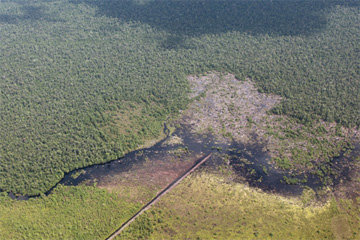Converting peatlands for wood-pulp and oil palm plantations generates nearly 1,500 tons of carbon dioxide per hectare, making these ostensibly “green” sources of paper, vegetable oil and biofuels important drivers of climate change, reports new research published by scientists at the Center for International Forestry Research (CIFOR).
The study, published in the Proceedings of the National Academy of Sciences (PNAS), found that oil palm plantations established on peat soils generate nearly 60 tons of carbon dioxide per hectare over their 25-year life cycle. Roughly 62 percent of emissions arise from decomposition of peat, while 25 percent are released when the vegetation is burned shortly after clearing. Additional emissions result from use of nitrogen-based fertilizers. With more than 100,000 hectares of peatlands in Southeast Asia—primarily Indonesia—being converted every year for plantations, the research suggests Indonesia could fail to meet emissions targets if it doesn’t limit conversion of peatlands.
“There needs to be urgent action to halt the current tremendous rate of destruction of forested peatlands” said Daniel Murdiyarso, the study’s lead author, in a statement.
 Draining and clearing of peat forest in Central Kalimantan, Indonesia. Photo by Rhett A. Butler. |
But avoiding conversion of peatlands is easier said than done. Indonesia has ambitious goals for expanding pulp and palm oil production and has already granted extensive concessions on peatlands, which can be highly productive and are generally more readily available than non-peat soils. Buying companies out of existing concessions can be cost-prohibitive: an oil palm plantation can be worth more than $5000 per hectare given current palm oil prices, far in excess of what could be offered under the proposed reducing emissions from deforestation and degradation (REDD), a carbon emissions mitigation mechanism which could compensate landowners for conserving forests.
Accordingly, the authors—Murdiyarso, Kristell Hergoualc’h and Louis Verchot—argue that any future REDD deal include a “special focus” on peatlands.
“Unless future global climate policies create significant financial incentives to overcome the economic drivers of deforestation, REDD+ will not be able to compete financially,” said Verchot. Including carbon stored in peatlands in a REDD agreement, would make the carbon conservation initiative more competitive financially with plantations.
“It is now the right time to promote the peatlands sector to be included in the new climate regime,” the authors write.
“The REDD+ mechanism offers an opportunity not only to manage peatlands more sustainably, but also to settle a number of agendas related to social and legal issues. It is timely to promote the eligibility of reducing GHGs emissions from peatlands in the new climate regime.”
D. Murdiyarso1, K. Hergoualc’h, and L. V. Verchot (2010). Opportunities for reducing greenhouse gas emissions in tropical peatlands. PNAS www.pnas.org/cgi/doi/10.1073/pnas.0911966107
Related articles